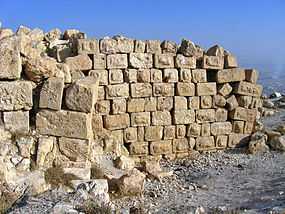Alexandrium
| Alexandrium | |
|---|---|
|
Hasmonean wall at Alexandrium | |
 Shown within the Palestinian territories | |
| Alternate name | Alexandrion, Sartaba |
| Location | Jericho Governorate, West Bank |
| Region | Judea |
| Coordinates | 32°5′45″N 35°27′41″E / 32.09583°N 35.46139°ECoordinates: 32°5′45″N 35°27′41″E / 32.09583°N 35.46139°E |
| Type | Fortification |
| History | |
| Builder | Probably Alexander Jannaeus |
| Founded | 1st century BC |
| Abandoned | About 70 AD |
| Periods | Hellenistic to Roman Empire |
Alexandrion or Alexandrium, sometimes referred to as Sartaba, was a fort constructed by the Hasmoneans[1] on a mountain between Scythopolis and Jerusalem, near the Jordan Valley.[2] It was likely named after Hasmonean king Alexander Jannæus (104-77 BCE).
History
Alexandrium was constructed by the Hasmoneans near the border with Samaria to accommodate a military garrison, as well as to guard political prisoners.[3] It is later mentioned during Pompey the Great's conquest of Judea as a stronghold of Aristobulus II: "When, in the year 64, Pompey marched past Pella and Scythopolis to Coreæ, on the northern boundary of Judea, Aristobulus II fell back on Alexandrium."[4]
The fort was restored by Herod the Great, a task he assigned to his brother Pheroras. Herod used the fort as a prison for his political opponents, holding his wife Mariamne and mother Alexandra there in 30 BCE. It was also the burial site of Alexander and Aristobulus, the two sons Herod had executed at Sebaste in 7 BCE.[2]
Alexandrium was finally razed by Vespasian or Titus during the Great Revolt.[5]
References
Notes
- ↑ Josephus, Antiquities of the Jews 13:417
- ↑ 2.0 2.1 Rocca 2008, pp. 30-32
- ↑ Rocca 2008, p. 12
- ↑ Josephus, Antiquities of the Jews 14:48
- ↑ Krauss, Samuel. "ALEXANDRIUM". JewishEncyclopedia.com. Retrieved May 7, 2011.
Bibliography
- Josephus, Flavius. William Whiston, A.M., translator (1895). The Works of Flavius Josephus. Auburn and Buffalo, New York: John E. Beardsley. Retrieved 15 July 2010.
- Rocca, Samuel (2008). The Forts of Judaea 168 BC – AD 73. Oxford, United Kingdom: Osprey Publishing. ISBN 978-1-84603-171-7.
External links
| Wikimedia Commons has media related to Sartaba. |
